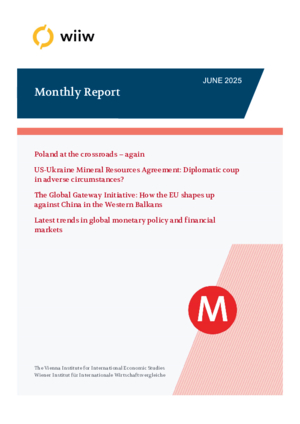Monthly Report No. 6/2025
Gunter Deuber, Marcus How, Biljana Jovanovikj, Grzegorz W. Kolodko and Bernd Christoph Ströhm
wiiw Monthly Report No. 6, June 2025
35 pages including 6 Tables and 9 Figures
- Poland at the crossroads – again
by Grzegorz W. Kolodko
Sometimes, instead of solving a problem, democracy complicates it even further. This is precisely what we are seeing in Poland, which – after the presidential election – is doomed to continue the cohabitation of a government and a president with opposing ideological and political orientations. In such conditions, it will be difficult for the Polish economy to follow a path of dynamic and sustainable development.
- US-Ukraine Mineral Resources Agreement: Diplomatic coup in adverse circumstances?
by Gunter Deuber and Marcus How
The US-Ukraine raw minerals agreement was a diplomatic success for the Zelensky administration – arguably the best possible outcome in the current circumstances. The agreement is in the very early stages of implementation and is highly unlikely to become fully effective until a sustainable peace agreement is in place between Russia and Ukraine. It could serve as a blueprint for future bilateral resource-for-reconstruction deals, while other countries may follow suit in formalising their support for Ukraine through similar frameworks.
- The Global Gateway Initiative: How the EU shapes up against China in the Western Balkans
by Bernd Christoph Ströhm
The EU’s Global Gateway Initiative which was established to compete with China’s Belt and Road Initiative, aims to improve digital connectivity, infrastructure and sustainable development in the EU’s backyard – including in the Western Balkan region. However, bureaucratic obstacles and a lack of political consensus have delayed its implementation. The EU runs the risk of a further loss of credibility and influence in the region if it does not carry through its projects under this ambitious initiative.
- Latest trends in global monetary policy and financial markets
by Biljana Jovanovikj
Late 2023 and early 2024 marked the beginning of a gradual shift toward monetary easing, as inflation in the advanced economies began moving closer to target and growth momentum softened. However, the outlook became significantly more uncertain in early 2025, following the imposition of US tariffs and the escalation of global trade tensions. The key question now is not only the pace and timing of further rate cuts, but also whether heightened geopolitical and trade-related risks will delay or even reverse the easing cycle in some countries.
Reference to wiiw databases: wiiw Monthly Database, wiiw FDI Database
Keywords: nationalism, economic populism, presidential elections, Mineral Resources Agreement, economic and military aid, security guarantees, Global Gateway Initiative, Belt and Road Initiative, infrastructure investments, policy rates, inflation, yield curves
Countries covered: Canada, China, EU, Euro Area, Japan, Poland, Switzerland, Ukraine, United Kingdom, US, Western Balkans
Research Areas: Macroeconomic Analysis and Policy, Sectoral studies
